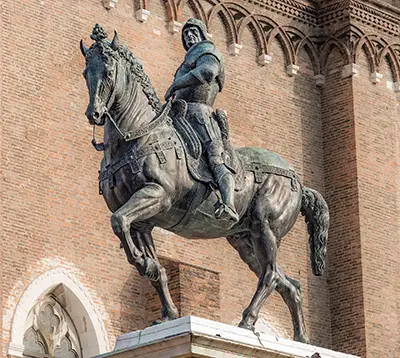Andrea del Verrocchio's equestrian statue of Bartolomeo Colleoni, Venetian condottiere, is a masterpiece of Renaissance art.
Drawing its inspiration from classical statuary, as well as earlier 15th century masterworks such as Donatello's equestrian monument to condottiere Erasmo da Narni, Verrocchio's statue epitomises the advanced wax sculptural techniques and bronze casting skills of the late 15th century. Verrocchio himself contributed to this proficiency in no small measure, with his own innovatory ideas being successfully executed in the monument he created to Colleoni, a monument that the condottiere had requested and commissioned before his death.
At over 12 feet high (ca. 3.5 metres), Verrocchio’s statue opposite the Scuola de San Marco in Venice’s Campo Santi Giovanni e Paolo would impress even at ground level. Mounted on a pedestal designed by the artist Alessandro Leopardi, which is over twice the height of the sculpture, Colleoni’s image dominates its location as the condottiere himself dominated military life in the region. Leopardi was also responsible for casting the statue in bronze, for Verrocchio did not live to see his masterwork completed.
Clad in armour, Colleoni rides with his left shoulder and elbow thrust boldly forward, with right arm and sword hand, gripping a baton, concealed behind his horse when viewed from left and below. Authoritative and proud, Colleoni's gaze is also focused to the left, his grim expression that of the supreme commander leading, or perhaps reviewing, his troops. He could equally be surveying his conquered foes, the enemies of Venice.
His horse's head tilts in the same direction while it steps straight forward under him. However, responding to the touch of the rein on its neck, as well as to Colleoni's strained torso and powerful leg pressure, the suggestion is that it is about to display a series of controlled movements, impressing the viewer. It is a reminder of the contribution made by medieval and early modern Italian states to the equestrian tradition, with Neapolitan war horses in great demand throughout Europe. It is also testimony to the genius of Verrocchio in creating the sense of such power and movement in a static form.
As noted, Verrocchio's statue is frequently compared with Donatello’s earlier statue of the Venetian condottiere, Erasmo da Narni (nick-named "Gattamelata"). In fact, Colleoni served under da Narni. However, the two statues indicate diverse approaches, creating different impressions of the two leaders. Donatello created a relaxed rider on his powerful horse, whereas Verrochio’s statue conveys the tension and energy of a military leader in his masterful prime. Verrocchio's horse raises one foreleg over space, increasing the sense of potency, while Donatello resolved this by placing a sphere between the horse’s upraised hoof and the pedestal.
It's clear that 15th century artists were presenting equestrian imagery in ways that had previously been the exclusive use of past rulers, as shown in the famous equestrian statue of Marcus Aurelius. Now, through statuary and imagery such as that of Uccello’s funerary image of Sir John Hawkwood, the heroic extended beyond the supreme ruler, to generals and military leaders too. They are part of a sea-change in art that would see mighty equestrian statues dominating the cities of both the old and new worlds into the 20th century.
One of the fascinating mysteries about this exquisite piece of statuary is why the completion work did not pass to Verrocchio's student, Leonardo da Vinci. In creating a memorial to Colleoni in the 1480s, Verrocchio chose to represent the condottiere as an indomitable leader. His vision was not based on his personal knowledge, since Colleoni was long dead by this time. Whether this truly represents a man who was also a philanthropist, donating money to Venetian charities, is hard to judge.




